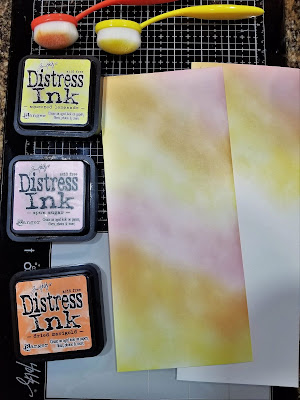Welcome back to Magenta Super Saturday and thank you for
visiting my blog. Slimline cards are
really popular right now so I decided to make one for today’s post. I used the Flower Mandala Background stamp
and my stamp positioner. I planned to
stamp, then color with colored pencils, then re-stamp the image and emboss with
gold embossing powder. You can also see
my card on the Magenta blog here.
To make the layout for this card work, I had to do some math and some experimenting. Since I wanted the stamped design to be centered I realized that I needed to cut the cardstock for the stamped image the same width as the stamp. To begin, I cut a piece of 80# white cardstock to measure 4
½” x 10 ¼”. (This is the width of the
stamp and twice the length of the stamp.)
I blended Squeezed Lemonade, Spun Sugar and Dried Marigold Distress inks
over the entire piece. I also blended
these same inks on a scrap of cardstock to use later for the sentiment.
After the inks had dried, I placed the
cardstock in the corner of my stamp positioner and stamped with VersaFine
Toffee ink. I rotated the paper and
stamped the image again. The bottom edges
of the stamped images will almost touch in the middle of the piece of
cardstock.
I colored all the mandalas with colored pencils (the colors
I used are listed below), then returned the cardstock to my stamp
positioner. I used a powder tool over
the entire piece, stamped with VersaMark, then embossed with Brutus Monroe Gilded Gold embossing
powder. I also stamped the thank you
sentiment, embossed with gold embossing powder and cut it out with a 2” circle
die.
To assemble the card, I began with the card base. The final size of the card is 4” x 9”. I cut the base cardstock to 8” x 9”, then
scored and folded in half. I cut a piece
of orange cardstock to 3 ¾” x 8 ¾” and also cut a 2 ¼” circle for the backing
of the sentiment. The final size of the
mandala piece is 3 ½” x 8 ½”, however, in order for the design to remain
centered I cut equal amounts from each side of the piece. I cut ½” from each long size and 7/8” from
each end. After assembling I added a few
sequins for a bit of sparkle.
Here are the final measurements:
Base card: 8"x9", scored and folded in half at 4" to make a card that measures 4" x 9"; Matting cardstock: 3 3/4" x 8 3/4"; Stamped image: Original size was 4 1/2" x 1- 1/4", then cut to 3 1/2" x 8 1/2".
One note, I used 110# cardstock for my card base but this
made the card weigh more than one ounce which increases the postage when you
mail the card. Using 80# cardstock will
decrease the weight and should keep it under one ounce.
If your stamp positioner can’t accommodate a longer piece of
cardstock, you can skip the second stamping step.

I also created some other panels with Distress inks and
Distress Oxide inks. Going left to right on the picture above I used I used Distress Oxide in Peacock Feathers, Evergreen Bough and Twisted Citron. When the ink was dry, I stamped and embossed with gold embossing powder, then used a Wink of Stella pen to color the mandalas for a bit of sparkle. For the next panel I used Distress Shaded
Lilac and Tumbled glass then colored with pencils (the colors are
listed below) and embossed with gold embossing powder. The middle panel is the one I used for today's card. For the fourth panel I stamped my image, then used small blending brushes to shade the mandalas with Distress Oxide Picked Raspberry and
Wilted Violet, then colored the open areas with Spun Sugar. When the ink was
dry I restamped the image and embossed with gold embossing powder. On the last panel, I blended Distress
Oxide Twisted Citron, Evergreen Bough and Lucky Clover inks over the entire panel and when the ink was dry, I stamped and
embossed with gold embossing powder. I again used a clear Wink of Stella pen to apply sparkle on the Mandalas.
This was a fun project and I ended up with several panels for more slimline cards. I hope you will give it a try. Thanks for visiting my blog today.
Magenta Products Used
Other Products Used
Prismacolor Pencils (Panel 1: Carmine Red PC926; Yellowed Orange PC1002; Pale Vermillion PC921; Crimson Red PC924; Permanent Red PC122; Spanish Orange PC1003) (Panel 2: China Blue PC1100; Lilac PC956; True Blue PC903; Violet Blue PC933; Imperial Violet PC1007; Peacock Blue PC1027)
Distress Inks
Distress Oxide Inks
VersaMark Ink
Brutus Monroe Gilded Gold Embossing Powder
Wink of Stella





















































